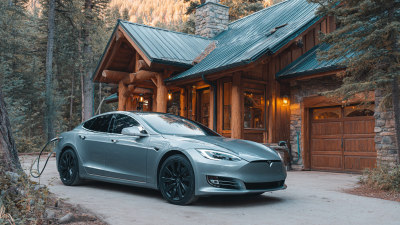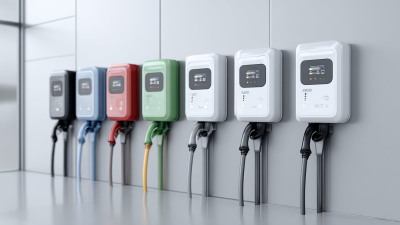As the automotive industry advances toward a more sustainable future, investment in Electric Vehicle Supply Equipment (EVSE) chargers becomes not just advantageous but essential. With the growing popularity of electric vehicles (EVs), a robust infrastructure of EVSE chargers is crucial to support this transition. The proliferation of EVs highlights the pressing need for accessible charging options that cater to the demands of an increasing number of electric vehicles on the road. This burgeoning market presents a unique opportunity for investors looking to capitalize on the inevitable shift toward electrification in transportation.
Investing in EVSE chargers not only aligns with environmental goals but also promises significant economic returns. As policymakers and consumers embark on a collective journey towards reducing carbon emissions, the demand for efficient and widespread EV charging solutions will undoubtedly surge. Forward-thinking investors who recognize the critical role of EVSE chargers in this landscape stand to benefit tremendously. By prioritizing investment in this infrastructure, they contribute to an ecosystem that promotes sustainable mobility while simultaneously reaping the financial rewards of early entry into a rapidly expanding market.

The transition to electric vehicles (EVs) hinges significantly on the availability and accessibility of Electric Vehicle Supply Equipment (EVSE) chargers. As the demand for EVs continues to rise, the infrastructure surrounding them must expand correspondingly. EVSE chargers play a crucial role in addressing range anxiety among potential electric vehicle buyers. By increasing the number of charging stations in urban and rural areas, consumers will feel more secure about making the switch to electric, knowing they can easily recharge their vehicles.

Moreover, the presence of widespread EVSE chargers contributes to the overall appeal of electric vehicles. As more businesses and municipalities invest in charging stations, the charging experience becomes more seamless and convenient. This not only enhances consumer confidence but also promotes a culture that embraces sustainability and innovation. By focusing on the expansion and improvement of EVSE infrastructure, we can significantly accelerate the adoption of electric vehicles, paving the way for a cleaner, more sustainable future.
Investing in Electric Vehicle Supply Equipment (EVSE) infrastructure is crucial for creating a sustainable ecosystem for electric vehicles (EVs). The growth of the EV market necessitates an extensive network of charging stations to accommodate the increasing number of electric cars on the road. By enhancing charging infrastructure, we not only support current EV users but also encourage potential buyers, fostering a transition toward greener transportation options.
Tip: When considering investments in EVSE, think about locations that will maximize visibility and accessibility, such as shopping centers, workplaces, and densely populated urban areas. This strategy will attract more users and ensure a steady utilization of charging stations.
Additionally, investing in EVSE brings financial benefits. As the demand for EVs rises, businesses that incorporate charging stations can see increased foot traffic, leading to higher customer engagement and sales. Government incentives and rebates for EVSE installation can also provide financial relief, making it an attractive investment.
Tip: Stay informed about local and federal incentives for EVSE investments, as these can significantly offset initial costs. Networking with other businesses and organizations involved in green technologies can also provide valuable insights and potential partnerships.
The expansion of the Electric Vehicle Supply Equipment (EVSE) charger market is being propelled by significant technological innovations. According to a report by ResearchAndMarkets, the global EVSE market is projected to grow from $7.5 billion in 2020 to over $40 billion by 2026, fueled by advancements in charging technology and infrastructure. Innovations such as ultra-fast charging stations and smart charging solutions are enhancing the convenience and efficiency of charging electric vehicles, making them more appealing to consumers.
One key area of innovation is the integration of renewable energy sources into EVSE systems. By utilizing solar or wind energy, charging stations can operate more sustainably and reduce dependence on traditional power grids. Furthermore, the advent of Vehicle-to-Grid (V2G) technologies allows electric vehicles to not only draw power but also supply energy back to the grid, creating a symbiotic relationship between EVs and energy providers.
Tips: As a business looking to invest in EVSE chargers, research local regulations and incentives that support EV infrastructure development. Additionally, consider partnering with technology firms specializing in smart charging solutions to stay ahead in this rapidly evolving market. Engaging with community stakeholders will also help in identifying the most strategic locations for installation.
Government policies and incentives play a crucial role in expanding the Electric Vehicle Supply Equipment (EVSE) market, which is essential for the future of electric vehicles. According to industry analysts, the U.S. electric vehicle charger manufacturing market is projected to grow significantly, from $761.7 million in 2025 to an impressive $3,494.5 million by 2032, representing a compound annual growth rate (CAGR) of 24.3%. This rapid growth highlights the increasing demand for EVSE infrastructure, driven in part by supportive governmental measures.
One important initiative is California's Fast Charge California Project, which recently launched a $55 million incentive program aimed at expanding public electric vehicle fast charging stations. Such programs not only help improve accessibility for EV owners but also support the wider adoption of electric vehicles by mitigating range anxiety. Furthermore, with the expiration of electric vehicle tax credits in 2025, the urgency for infrastructure development will become even more pronounced, as consumers will increasingly rely on public charging solutions to complement their EV ownership experience.
| Region | Number of EVSE Chargers (2023) | Government Incentives ($ Millions) | Projected Growth Rate (2024-2030) |
|---|---|---|---|
| North America | 150,000 | 200 | 25% annually |
| Europe | 300,000 | 350 | 30% annually |
| Asia-Pacific | 500,000 | 500 | 40% annually |
| Latin America | 50,000 | 50 | 20% annually |
| Middle East & Africa | 20,000 | 30 | 15% annually |
The proliferation of Electric Vehicle Supply Equipment (EVSE) chargers is crucial not only for the growth of electric vehicles (EVs) but also for enhancing the user experience and shaping public perception. According to a recent report from the International Energy Agency (IEA), the number of public charging stations worldwide grew by over 40% in 2021, indicating a strong commitment to infrastructure development. As EV adoption accelerates, having a robust network of charging stations can significantly reduce range anxiety, making EVs more appealing to potential buyers.
EVSE chargers can also improve user experience through technological innovations such as fast charging and renewable energy integration. A study by BloombergNEF estimated that charging technology improvements could cut charging times by 50% by 2030, making EV ownership more convenient. Furthermore, as municipalities invest in EVSE infrastructure, public charging stations become a cornerstone for reaching sustainability goals, enhancing community perception of electric mobility. The relationship between accessible charging and user satisfaction cannot be understated; a seamless charging experience fosters a positive halo effect, thereby encouraging more consumers to transition to electric vehicles.















